I’m often drawn to cars and trucks from some of the less popular American automakers. I’d primarily contribute that to my affinity for the less common, but I maintain they have appeal otherwise. This 1962 Studebaker Champ, for example, offers a unique look, compact(ish) size, and utilitarian function. If that checks the boxes for you, you can find it here on Facebook Marketplace in Chatham, Illinois for $5,375.
The Champ was introduced for the 1960 model year, representing an all-new look for Studebaker pickups. Trying to keep costs down, Studebaker sourced most exterior parts from existing models/manufacturers. The cab was a cut-down Lark sedan; the 1960 bed was leftover from the previous Studebaker truck generation; the wide bed introduced in 1961 was borrowed from Dodge, and the chassis was from a previous generation Studebaker truck. That formula allowed the Champ to come to fruition. From 1960-1964 Studebaker built approximately 27,000 Champs – 7,325 of those were from the 1962 model year, which was the highest production model year.
This truck appears to be wearing Gem Green paint that I’d surmise is original. As is obvious in the photos, the seller tells us “Yes it has rust!!” The cab floor shows significant rust with some of it being through. The bed floor is in slightly better shape. The exterior trim looks to all be present and in usable condition, even down to the hood ornament. I commend previous owners for resisting the urge to paint this – or do partial repair – and keep the exterior one color and seemingly original for 60 years. Aftermarket wheels are wrapped in mismatched tires.
A black vinyl bench seat contrasts the door cards that match the exterior paint. The metal dash is painted blue and plated metal trim is heavily corroded. The 3-pedal setup remains, even though the seller tells us this is an automatic transmission truck. The shifter is floor-mounted and features a classic rubber boot. You’ll find a sliding rear window – a feature that Studebaker introduced to the world in the first model year of the Champ.
A 289-cubic inch V8 was optional, but the seller tells us a 302-cubic inch V8 powers this green gem. Presumably a swap with the floor-mounted automatic transmission. The seller states that they’ve changed the battery, gas, oil, and starter, but the truck still has no power. Consider this one a non-running project.
If you don’t mind some exterior blemishes, this Studebaker may make for a tidy winter project. Personally, I’d first update the brakes, then get it running like a scalded dog, and eventually fully finish the interior to be better than new. I’m a firm believer in rusty but trusty and I like my interior comfy. This Champ looks like an excellent candidate for that.




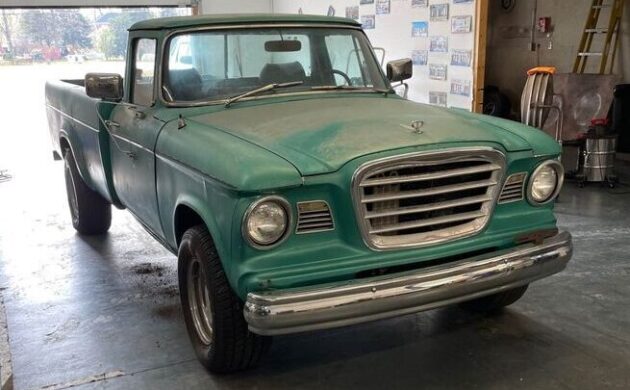


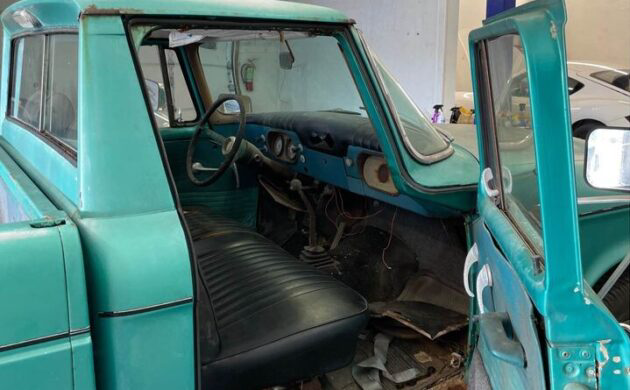
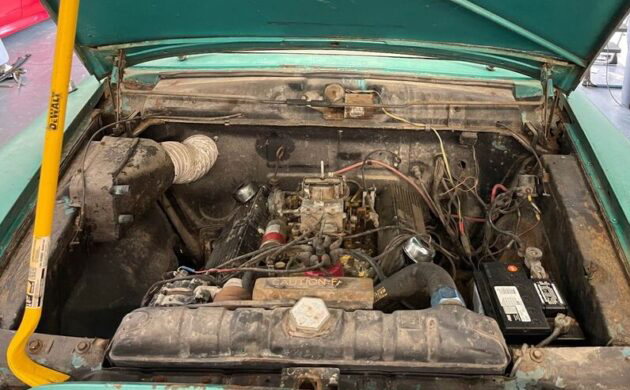

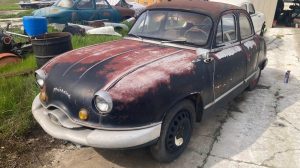
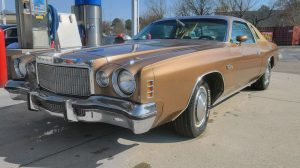
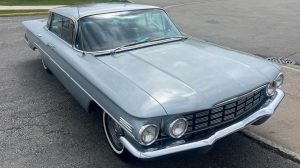
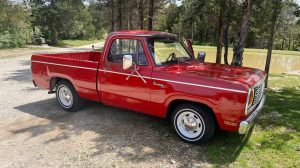


If you were inclined to haul things, the original 289 would have been a better truck engine in my opinion. I have a ’62 GT hawk with that motor that could pull stumps. Or take off in 4th gear at 20mph, take your choice.
This truck demonstrates how desperate Studebaker was. They used the Lark body, despite the fact that the truck bumper wouldn’t line up properly, and they used the discarded Dodge bed, despite the facts that it was wider, its sides were flatter, and its character lines didn’t match the Lark body. No auto executive would approve a mix-and-mismatch approach like this unless the only alternative was to cease production entirely.
Very true, CCFisher, this pickup has the “cobbled together with bits from the parts bin” look. The Dodge bed with the Lark cab looks terrible and the front bumper looks like it was just thrown at the front end. I’m surprised Studebaker sold any of these trucks. They must have been sold cheap to get anybody to buy them. However, it’s a pretty scarce truck, one not often seen so it has that going for it. If you’re the kind of guy who is into automotive oddballs, here it is.
Naturally, in our “must be perfect” world today, we can see the glaring mistakes, but in the late 50s, Studebaker, possibly still resting on its laurels from Da’ Big One, was a viable truck alternative to the Big 4. Cars, not so much, but In a 2wd setting, Studebaker was a sound #5( behind IH #4), and by the early 60s, it was pretty clear to most, Studebaker was going down. They made the Champ out of the “parts bin”, as a last ditch effort. I think the management was completely behind this, so as to avoid any re-tooling, and it worked,,,kind of. Champs were actually great trucks, using most all off the shelf items, most war- proven, but just didn’t have the zing. I heard, it was partially the name, just sounded old fashioned, when nothing was further from the truth. I always liked the Lark, and a Lark themed truck was the coolest, but I am a bit weird. I’d love to have one today.
Management, as noted, was not onboard. Sherwood Egbert had been hired as CEO from McCullough…and his unspoken-but-plain mission was to gracefully exit the auto biz.
In typical Studebaker-Packard tradition, they picked the wrong man. Egbert became a born-again pistonhead, and wanted to expand, not wind down.
But, the board had its priorities. While the Champ was being cobbled together in pre-production, with Lark money flowing in, Studebaker went on a buying spree – STP, Onan, Alco, Gravely.
It wasn’t at this point that they were desperate. They were looking to shift the business. Probably, with the winding down of Packard, the directors did some soul-searching, and came to conclusions that would show in their 1963 and 1966 closures.
They had money, at that point – they just weren’t going to spend any more than they could avoid, on the car line. The Champ was a sort-of-updating, of a good work truck chassis…getting away from the 1950-ish cab styling. It was still as practical as a work truck, and that was probably the market Studebaker was trying to keep for a time.
Thanks, JPT, your posts always bring perspective. Care to become a member? It just seems, the pickup truck market wasn’t what it is today, and a complete retooling wasn’t feasible and a “cobbled” unit was all that was needed for the few that actually wanted a Studebaker pickup. It should be noted, Studebaker dabbled in the HD truck market with the Transtar, using the E series cab, but aside from a few industries in South Bend, they didn’t sell.
In hindsight, they should have stuck with the Scotchman.
Shaky ground, there, Oldog. I believe it was called the “Scotsman”, and depicted the frugalness(?) of the Scots. They were generally no frills, bottom of the line offerings, and probably offends someone today.
Being called “Scotch” instead of “Scots” p*sses them off too – My mother was 100% right from the island Scottish , and that always got that side of the family ticked off…that or being called Irish from people that didnt know the accent.
What if you corrected the afore mentioned shortcomings. You’d have a pretty good custom.
I sold mine with a 4 speed and
original running
259 V8 for much less. It had a lot of rust but sure looked good from 50 feet . Harder than heck to maneuver and after two trips in traffic said this is crazy.You needed Popeye arms to turn the wheel and parking it was a serious task. I loved that truck but there was a guy who was gonna put a better cab on it so I sold it. It was rare but in this case rarity
meant little.
This car is a manual transmission. You can see the old shifter base on the column. If it had an automatic, the shift quadrant would stick up at the top of the column. I suspect this is a 3-on-the-floor conversion. Owner should change the ad to reflect the correct gearbox.
These were rare when brand new. I’ve never seen one in the wild.
agreed:
Only 1 I ever saw was in a NV junk yrd
disagreed:
not “cobbled together” as that is still a manufacturing custom (&/or what about IH light division @ the time – it pulled from the bigger auto co.s AND the suppliers – like dana, spicer, BW, etc).
Like the truck, like the company (all models).
From the cab forward these trucks have a nice look to them ; I dont even mind the low fitting front bumper . Its too bad Studebaker didnt have the cash to design a bed that actually looked right on the Lark cab, the old Dodge beds make this truck look awkward , like someone putting a Chevy bed on a Ford – it works, but it doesn’t look right . Nothing was going to save Studebaker as a car line anyway , and as has been stated they were looking to get out of the business , but it really would have been a cool truck if the lines matched
Hey guys, older gentleman that I worked for , said don’t make lite of another man’s vehicle it my be just the one for you, little humor there I enjoyed the comments on the champ, I’ve owned a 1939 coupe express for the 55 years, it’s whatever makes you Happy